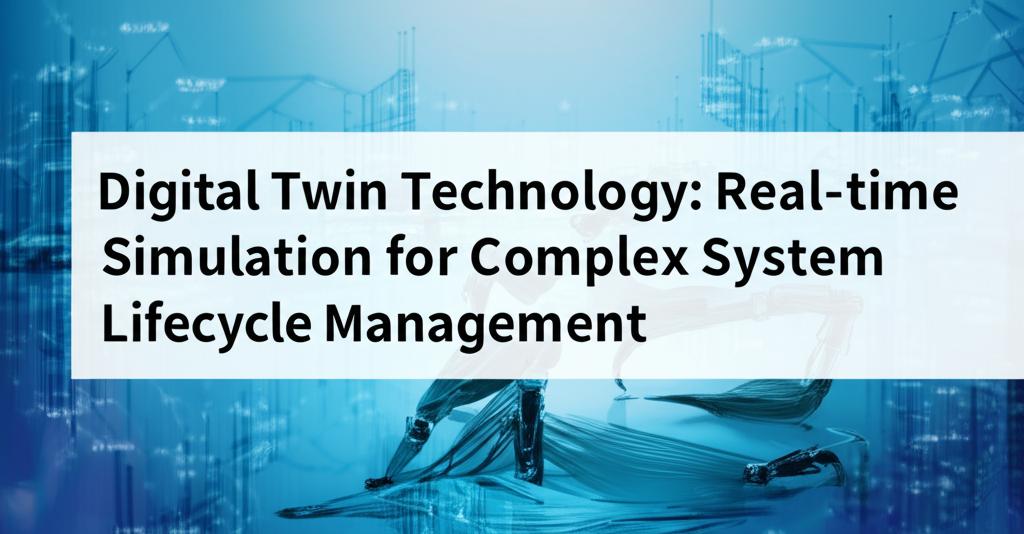Digital twin technology represents a significant leap forward, bridging the physical and digital realms to revolutionize how we manage complex systems throughout their entire existence. It moves beyond static blueprints or traditional simulations by creating a dynamic, virtual counterpart of a physical asset, process, or system. This digital replica is continuously updated with real-time data gathered from sensors installed on its physical counterpart, allowing for a two-way flow of information.
Core Functionality: Beyond Simple SimulationAt its heart, a digital twin works by using technologies like the Internet of Things (IoT) to collect data from a physical object or system. This data – reflecting operational status, environmental conditions, performance metrics, and more – is fed into the virtual model. Unlike traditional simulations which often study a specific process in isolation or use static data, a digital twin offers a richer, interactive virtual environment. It leverages this real-time data stream to accurately mirror the current state and behaviour of the physical entity.
This dynamic connection enables sophisticated real-time simulation. Users can run numerous "what-if" scenarios on the digital twin without impacting the physical world. This allows for testing under different conditions, predicting future performance or potential failures, and optimizing operations based on live feedback.
Managing the Entire LifecycleThe true power of digital twins lies in their application across the complete lifecycle of complex systems:
- Design and Development: Before physical construction or production begins, digital twins serve as virtual prototypes. Engineers can simulate various designs, test different materials or configurations, identify potential flaws early, and optimize for performance and efficiency, significantly accelerating development time and reducing the need for costly physical prototypes.
- Production and Construction: During manufacturing or construction, digital twins monitor progress in real-time. They can track assembly line efficiency, ensure quality control, identify delays or resource shortages, and visualize the build process. In construction, overlaying Building Information Modeling (BIM) data with real-time sensor input enhances project visibility and coordination.
- Operation and Monitoring: Once operational, the digital twin provides a continuous, real-time view of the asset's performance. Operators can monitor vital signs, detect anomalies instantly, understand how the system is behaving under actual conditions, and make immediate adjustments for optimal efficiency.
- Maintenance and Optimization: By analyzing real-time and historical data, often enhanced with AI and machine learning, digital twins excel at predictive maintenance. They can anticipate potential equipment failures before they occur, allowing maintenance to be scheduled proactively, minimizing downtime, extending asset lifespan, and reducing operational costs. Optimization simulations can identify ways to improve energy efficiency or throughput.
- Enhancements and End-of-Life: Digital twins support planning for upgrades, modifications, or decommissioning. They provide a detailed model for evaluating the impact of changes and planning structural enhancements or safe disposal.
Implementing digital twin technology yields significant advantages:
- Improved Performance and Efficiency: Real-time insights enable continuous optimization of operations and asset performance.
- Predictive Capabilities: Anticipating failures reduces costly downtime and improves reliability.
- Reduced Costs: Savings come from optimized maintenance, reduced prototyping, faster development, and fewer operational disruptions.
- Enhanced Decision-Making: Comprehensive data and simulation capabilities provide a solid foundation for informed strategic and operational choices.
- Accelerated Innovation: Faster testing and validation of new ideas and designs shorten time-to-market.
- Increased Safety: Remote monitoring reduces the need for personnel in hazardous environments, and simulations can identify potential safety risks.
- Sustainability: Optimizing resource usage, energy consumption, and waste reduction contributes to environmental goals.
Digital twins are transforming numerous sectors:
- Manufacturing: Optimizing production lines, predictive maintenance for machinery, quality control, and virtual commissioning of smart factories.
- Energy and Utilities: Managing power grids, optimizing renewable energy generation (like wind turbines or solar farms), predicting maintenance needs for infrastructure, and managing smart water/gas systems.
- Automotive and Aerospace: Simulating vehicle performance, testing autonomous driving systems, optimizing manufacturing processes, and predictive maintenance for aircraft engines.
- Construction and Infrastructure: Real-time project monitoring, simulation for structural integrity, planning maintenance for bridges or tunnels, and optimizing facility management.
- Smart Cities: Modeling urban environments for traffic flow optimization, energy usage monitoring, emergency response planning, and infrastructure management.
- Healthcare: Creating virtual patient models for personalized treatment planning, simulating surgical procedures, and optimizing hospital operations.
The evolution of digital twin technology is accelerating, driven by key trends:
- AI and Machine Learning Integration: AI enhances predictive analytics, enables autonomous decision-making within the twin ("Semantic Twins"), and allows for deeper insights from complex data. Generative AI is also being explored to enrich twin capabilities.
- IoT Expansion: More sophisticated sensors and wider IoT adoption provide richer, more granular real-time data streams.
- System-Level Twins: Moving beyond individual assets to create interconnected twins of entire systems or value chains for holistic optimization.
- AR/VR Integration: Immersive technologies allow users to interact with digital twins in more intuitive ways for training, maintenance guidance, and collaborative design reviews.
- Increased Focus on Sustainability: Using twins to model environmental impact and optimize for resource efficiency.
- Edge Computing and 5G: Enabling faster processing and analysis of data closer to the source for even quicker real-time responses.
Despite the benefits, implementation faces hurdles such as the initial cost, integrating data from diverse sources (including legacy systems), ensuring data security and privacy, the need for standardization, and acquiring the expertise to build and manage complex digital twins.
ConclusionDigital twin technology, powered by real-time simulation and data integration, offers an unprecedented ability to understand, manage, and optimize complex systems throughout their lifecycle. As AI, IoT, and connectivity continue to advance, digital twins will become increasingly integral to driving efficiency, innovation, and sustainability across virtually every industry, fundamentally changing how we interact with the physical world.

